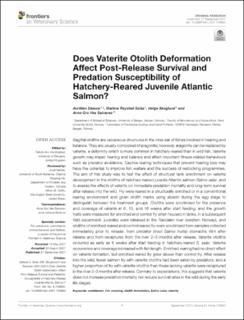| dc.contributor.author | Delaval, Aurelien Nicolas | |
| dc.contributor.author | Solås, Martine Røysted | |
| dc.contributor.author | Skoglund, Helge | |
| dc.contributor.author | Salvanes, Anne Gro Vea | |
| dc.date.accessioned | 2021-09-28T07:00:01Z | |
| dc.date.available | 2021-09-28T07:00:01Z | |
| dc.date.created | 2021-09-03T14:21:47Z | |
| dc.date.issued | 2021 | |
| dc.identifier.issn | 2297-1769 | |
| dc.identifier.uri | https://hdl.handle.net/11250/2783896 | |
| dc.description.abstract | Sagittal otoliths are calcareous structures in the inner ear of fishes involved in hearing and balance. They are usually composed of aragonite; however, aragonite can be replaced by vaterite, a deformity which is more common in hatchery-reared than in wild fish. Vaterite growth may impair hearing and balance and affect important fitness-related behaviours such as predator avoidance. Captive rearing techniques that prevent hearing loss may have the potential to improve fish welfare and the success of restocking programmes. The aim of this study was to test the effect of structural tank enrichment on vaterite development in the otoliths of hatchery-reared juvenile Atlantic salmon Salmo salar, and to assess the effects of vaterite on immediate predation mortality and long-term survival after release into the wild. Fry were reared in a structurally enriched or in a conventional rearing environment and given otolith marks using alizarin during the egg stage to distinguish between the treatment groups. Otoliths were scrutinised for the presence and coverage of vaterite at 6, 13, and 16 weeks after start feeding, and the growth traits were measured for enriched and control fry when housed in tanks. In a subsequent field experiment, juveniles were released in the Rasdalen river (western Norway), and otoliths of enriched reared and control reared fry were scrutinised from samples collected immediately prior to release, from predator (trout Salmo trutta) stomachs 48 h after release and from recaptures from the river 2–3 months after release. Vaterite otoliths occurred as early as 6 weeks after start feeding in hatchery-reared S. salar. Vaterite occurrence and coverage increased with fish length. Enriched rearing had no direct effect on vaterite formation, but enriched reared fry grew slower than control fry. After release into the wild, fewer salmon fry with vaterite otoliths had been eaten by predators, and a higher proportion of fry with vaterite otoliths than those lacking vaterite were recaptured in the river 2–3 months after release. Contrary to expectations, this suggests that vaterite does not increase predation mortality nor reduce survival rates in the wild during the early life stages. | en_US |
| dc.language.iso | eng | en_US |
| dc.publisher | Frontiers | en_US |
| dc.rights | Navngivelse 4.0 Internasjonal | * |
| dc.rights.uri | http://creativecommons.org/licenses/by/4.0/deed.no | * |
| dc.title | Does vaterite otolith deformation affect post-release survival and predation susceptibility of hatchery-reared juvenile Atlantic Salmon? | en_US |
| dc.type | Journal article | en_US |
| dc.type | Peer reviewed | en_US |
| dc.description.version | publishedVersion | en_US |
| dc.rights.holder | Copyright 2021 the authors | en_US |
| dc.source.articlenumber | 709850 | en_US |
| cristin.ispublished | true | |
| cristin.fulltext | original | |
| cristin.qualitycode | 1 | |
| dc.identifier.doi | 10.3389/fvets.2021.709850 | |
| dc.identifier.cristin | 1931192 | |
| dc.source.journal | Frontiers in Veterinary Science | en_US |
| dc.identifier.citation | Frontiers in Veterinary Science. 2021, 8, 709850. | en_US |
| dc.source.volume | 8 | en_US |

